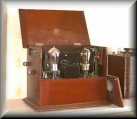Naming of a character to let the listener
know who is who and to avoid confusion
|
Essential to let the listener know who is in the scene. There are particular techniques of flagging characters' names.
when the character is to be named as he or she make their entrance. And when that name will next be reinforced. It then depends on how many are in the scene, how complicated is the plot action and what the sequence of plot events are. It may be necessary to distinguish characters if their voices are somewhat similar. In adapting stage plays, it is necessary to insert names. The protagonist, and there is usually a strong protagonist, also requires flagging by name. Gordon Lea 57
Assignment on naming |
CONTINUING THROUGH THE SITE: to record 'umms' from all the characters to store
|
|
|
|
|
|
|
|
|
|
|
|
|
|
|
'moving camera' technique |
|
|
|
'Will you turn that music down!' |
| drop-ins | sound pictures |
|
| number the scenes carefully with a system | voice in the mind = interiorizing |
|
|
|



